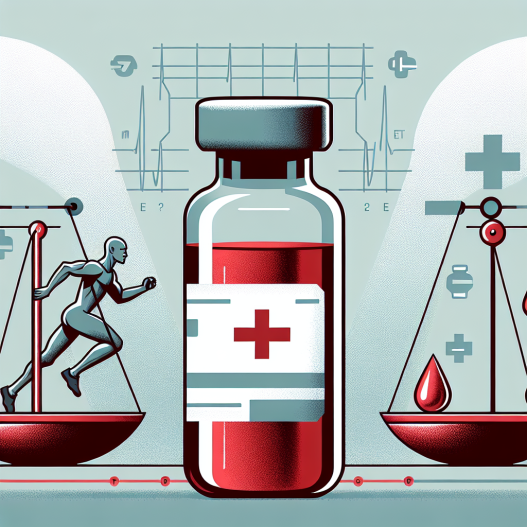-
Table of Contents
Erythropoietin: The Controversial Drug in Sports
Sports and performance-enhancing drugs have always been a hot topic in the world of athletics. Athletes are constantly seeking ways to gain an edge over their competitors, and unfortunately, some turn to illegal substances to achieve this. One such substance that has been at the center of controversy is erythropoietin (EPO). This hormone, naturally produced by the body, has been used by athletes to increase their red blood cell count and improve their endurance. However, the use of EPO in sports is not without its risks and ethical concerns. In this article, we will delve into the pharmacology of EPO, its effects on athletic performance, and the controversies surrounding its use in sports.
The Pharmacology of Erythropoietin
Erythropoietin is a glycoprotein hormone that is primarily produced by the kidneys in response to low oxygen levels in the body. Its main function is to stimulate the production of red blood cells in the bone marrow. Red blood cells are responsible for carrying oxygen to the body’s tissues, and an increase in their number can improve an athlete’s endurance and performance.
In the medical field, EPO is used to treat anemia, a condition characterized by a low red blood cell count. However, in the world of sports, it has been used as a performance-enhancing drug. EPO can be administered through injections or taken in pill form. It is also available in synthetic forms, such as epoetin alfa and darbepoetin alfa, which have a longer half-life and therefore require less frequent dosing.
Pharmacokinetics and Pharmacodynamics of Erythropoietin
The pharmacokinetics of EPO vary depending on the route of administration. When injected, it has a rapid onset of action, with peak levels reached within 24 hours. The half-life of EPO is approximately 5 hours, meaning it is quickly eliminated from the body. However, with repeated dosing, the half-life can increase to 24 hours due to the accumulation of the drug in the body.
The pharmacodynamics of EPO are also affected by the route of administration. When taken orally, the bioavailability of EPO is low, meaning only a small percentage of the drug reaches the bloodstream. This is due to the breakdown of the drug in the digestive system. On the other hand, when injected, EPO has a bioavailability of 100%, making it a more effective route of administration for performance enhancement.
EPO and Athletic Performance
The use of EPO in sports is primarily aimed at improving an athlete’s endurance. By increasing the number of red blood cells, EPO can improve the body’s ability to transport oxygen to the muscles, delaying the onset of fatigue and allowing athletes to perform at a higher level for longer periods. This can be especially beneficial in endurance sports such as cycling, running, and swimming.
Studies have shown that EPO can increase an athlete’s red blood cell count by up to 10%, resulting in a 5-10% improvement in endurance performance (Lippi et al. 2010). This may not seem like a significant increase, but in the world of competitive sports, even the slightest advantage can make a difference.
However, the use of EPO in sports is not without its risks and ethical concerns.
The Controversies Surrounding Erythropoietin Use in Sports
One of the main concerns with the use of EPO in sports is the potential for adverse effects. EPO can increase the risk of blood clots, which can lead to serious conditions such as stroke and heart attack. It can also cause an increase in blood pressure, which can be dangerous for athletes with pre-existing cardiovascular conditions.
Moreover, the use of EPO in sports raises ethical concerns. It gives an unfair advantage to those who use it, creating an uneven playing field for athletes who choose not to use performance-enhancing drugs. It also goes against the spirit of fair play and sportsmanship, which are the core values of athletics.
In recent years, there have been several high-profile cases of athletes being caught using EPO, resulting in suspensions and tarnished reputations. This has led to stricter testing and penalties for those who are found to be using the drug.
Expert Opinion
Despite the controversies surrounding its use, some experts argue that EPO should not be completely banned in sports. They believe that with proper monitoring and regulation, the use of EPO can be safe and beneficial for athletes. They also argue that banning EPO only leads to athletes finding other, potentially more dangerous, ways to enhance their performance.
Dr. Michael Ashenden, a leading expert on EPO and doping in sports, believes that the use of EPO should be allowed under strict medical supervision and with regular testing to ensure the safety of athletes (Ashenden, 2012). He also suggests that the World Anti-Doping Agency (WADA) should consider implementing a “therapeutic use exemption” for EPO, similar to the one already in place for other medications.
References
Ashenden, M. (2012). Erythropoietin: The good, the bad, and the ugly. British Journal of Sports Medicine, 46(4), 243-244.
Lippi, G., Franchini, M., Guidi, G. C., & Favaloro, E. J. (2010). Erythropoietin in sports: A review. European Journal of Internal Medicine, 21(3), 140-143.
Conclusion
Erythropoietin has been a controversial drug in the world of sports, with its use being banned by most athletic organizations. However, its potential to improve endurance and performance cannot be denied. While the use of EPO in sports raises ethical concerns and carries potential risks, some experts argue that with proper regulation and monitoring, it can be used safely and effectively. As the debate continues, it is important for athletes to consider the potential consequences of using EPO and to prioritize their health and well-being over winning at all costs.








